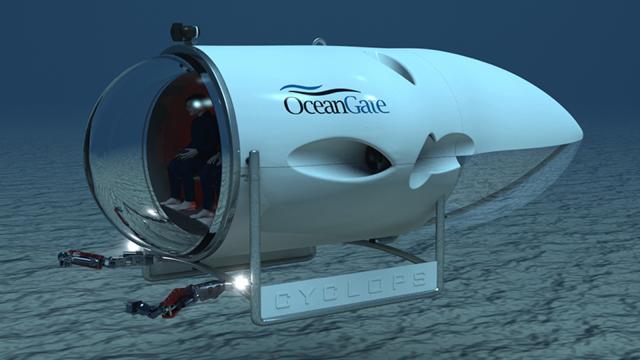In some ways, exploring the depths of the ocean is every bit as technically challenging as investigating the surface of Mars. In fact, we have a far more detailed understanding of the Red Planet than we do of what goes on under the sea. But this new, affordable manned submersible aims to open undersea exploration to everybody — not just the handful of wealthy nations that currently have the technology.
Under development by the OceanGate company since May of this year, the Cyclops submersible is a five-person submarine designed to perform a variety of underwater tasks. That includes scouting for mineral and gas deposits, biological specimen collection, and salavage operations, all for less than the cost of existing ROV platforms.
The Cyclops measures 5.5m long, 3.4m wide, and just over 2m tall. It weighs 8618kg on land, which is quite svelt for a manned sub, thanks to its unique, 7-inch thick carbon fibre hull construction.
As OceanGate CEO and Co-Founder, Stockton Rush, explained to Gizmodo:
Initially we looked at filament-wound carbon fibre. The belief was that we could use some of the technology that had, in fact, been used in Titan missiles. But as we looked at it, it became clear that these issues with [existing] carbon fibre pressure vessels — the ones that are currently constructed are designed for internal pressure — we are looking at something for external pressure
When you’re looking at high external pressure, the consistency of the matrix — in particular, the resin and the fibre — is critical. With [Boeing’s proprietary] Fibre Place Technology, you can lay the fibre in any orientation that you want without having to lap over the previous wind and you can get a consistency in the matrix that allows you to have a high confidence that you won’t end up getting micro-cracks that propagate in a catastrophic fashion.
Additionally, the sub’s 4-inch thick full hemispherical borosilicate glass viewport is the largest underwater glass structure of its kind, and will allow the sub to initially dive as deeply as 3000 metres, though the company is also working on a second model that will dive to twice that. Granted, neither Cyclops will be able to match the capabilities of China’s 7000m Jiaolong subs, but both should be more than sufficient for offshore energy exploration.
An external battery pack will provide enough power for eight hours of normal operation, though should something go wrong, the sub can remain underwater for up to 96 hours via its emergency life support system. Though customers will be able to tailor the subs to their specific expedition requirements, its typical loadout will include six 5000 lumen flood lights, a pair of five-axis manipulators, 2D and 3D sonar, and HD colour cameras.
But what most sets the Cyclops apart from nationally developed deep sea technologies is its affordability. By designing the vehicle for efficiency and incorporating as many off-the-shelf-parts as possible, rather than develop their own proprietary versions, OceansGate expects to rent these vehicles out for just $US35,000 a day — a bargain compared to the cost of conventional ROVs and manned platforms — when the subs hit the waves in 2016. [Ocean’s Gate]
